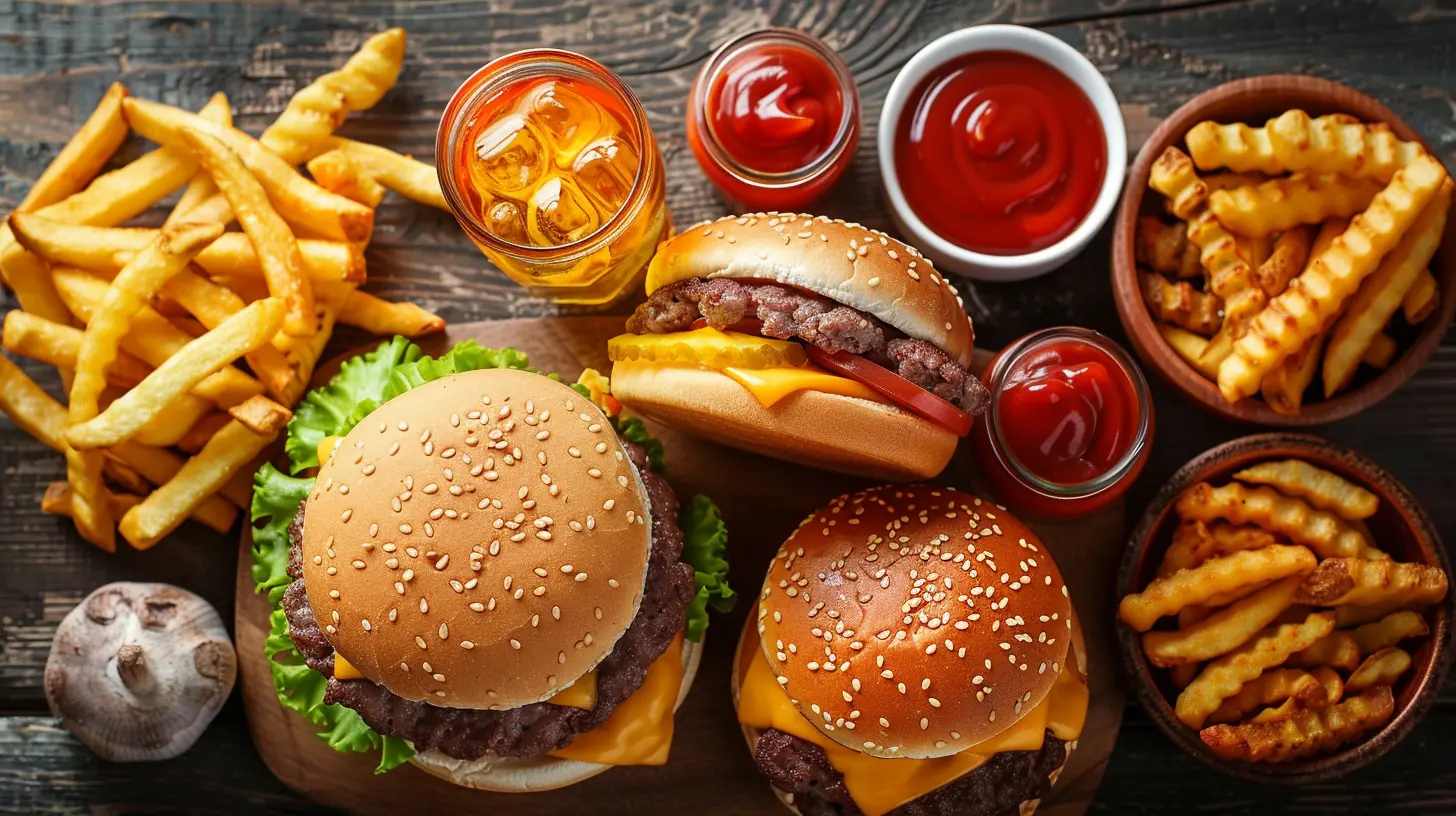How to Handle Food Refusal Without Resorting to Junk Food
7 June 2025
Parenting is a wild ride filled with sticky fingers, mysterious stains, and the occasional rogue Cheerio hiding in your shoe. But perhaps one of the greatest mysteries of all is this: why, oh why, do toddlers act like broccoli is made of lava?
If you've ever found yourself bargaining with a three-year-old over a bite of carrot like you're in high-stakes hostage negotiations — welcome, you're not alone. Food refusal is one of those parenting hurdles that makes you question both your patience and your pantry. And when you're about one cold chicken nugget away from giving up and rolling out the chip bag, just remember: there is hope.
Stick with me, and we’ll laugh our way through the chaos of picky eating, learn why kids turn their noses up at kale, and how to dodge the junk food temptation without going full Gordon Ramsay in the kitchen.
What Exactly Is Food Refusal, and Why Does It Feel Like a Personal Attack?
Let’s get this straight — food refusal isn’t your child plotting to drive you bonkers. (Even though it feels like it.) It’s a perfectly normal stage of development, usually peaking between ages 2 and 6.It can look like:
- Screaming at the sight of peas
- Flinging dinner across the room like a tiny angry chef
- Dramatically gagging at the suggestion of spinach
In reality, they’re learning independence, testing boundaries, and, believe it or not, learning to listen to their appetite. That doesn’t make it any easier to stomach (pun absolutely intended), but it does help frame it less like sabotage and more like growth.
Why Junk Food Feels Like The Easy Button (But Isn’t)
Let’s admit it — when your child eats NOTHING until 6 p.m. and you hand them a chicken nugget and they gobble it down like a famished raccoon? It feels like you just won at parenting.But here’s the catch: junk food offers an easy win, but it’s one that comes with a long-term price tag.
- It sets a preference for salty, sugary, or fatty foods.
- It conditions kids to expect reward-type foods after refusing healthy ones.
- It creates nutritional gaps that can lead to crankiness, sleep issues, and more epic tantrums.
Think of it like handing them candy for brushing their teeth — it makes no logical sense and it snowballs into a habit that’s tough to break.
The good news? There are ways to tackle food refusal without reaching for the neon-orange cheese puffs. Let’s dig in.
Step 1: Accept That You’re Not Running a Restaurant (and Your Kid Isn’t a Food Critic)
Repeat after me: “I am not a short-order cook.”You don’t need to make a bespoke meal every night for your little Gordon Ramsay. Serve one meal for everyone — with at least one “safe food” your child normally accepts. This could be bread, cheese, or even plain rice.
This tactic removes pressure and gives your child some control without turning dinner into a cooking competition.
Step 2: Get Creative — Because Presentation Totally Counts
Never underestimate a toddler who refuses to eat an egg… unless it’s shaped like a smiley face.Remember, we eat with our eyes first — and for kids, that’s very literal. So, play with presentation:
- Use cookie cutters to make star-shaped sandwiches
- Arrange veggies into rainbow patterns
- Create “dinosaur trees” out of broccoli (complete with roars)
You don’t need a culinary degree — just a bit of flair. Turning lunch into a scene from a Pixar movie gives you a surprising leg up.
Step 3: Ditch the Pressure — Seriously, No One Eats Well with Someone Staring at Them
Picture this: someone stares at you, arms folded, whispering, “Just one bite… you’ll love it.”Sound appetizing?
Kids don’t like pressure either. When they sense that you’re watching every fork movement like a hawk on espresso, they lock into stubborn mode. (It’s their superpower.)
Instead:
- Eat together, talk about your day
- Make mealtimes pleasant, not a battlefield
- Avoid rewards, punishments, or bribes for eating
Basically, play it cool. Like James Bond, but with mashed sweet potatoes.
Step 4: The Power of Choice — Because Every Toddler Is a Tiny Control Freak
Want your child to feel like a boss? Give them small, controlled choices. It satisfies their need for autonomy without letting them call all the shots.Use questions like:
- “Would you like carrots or cucumbers?”
- “Do you want your eggs scrambled or boiled?”
- “Should we use the red plate or the blue one?”
Let them feel heard. Because when kids feel in control, they’re less likely to put up a wall when the zucchini arrives.
Step 5: Normalize Rejection — And Keep Calm When They Spit It Out
Let’s get real: your child spitting out that lovingly prepared quinoa salad? Not the end of the world.Experts estimate that it can take up to 15-20 exposures before a child accepts a new food. That means:
- Seeing it on the table
- Touching it
- Smelling it
- Maybe licking it
- Screaming at it (yep, that counts too)
The key? Keep serving it. Casually. Consistently. Without the expectation that they must eat it.
It’s more about familiarity than culinary miracles.
Step 6: Involve Them in the Prep (Even If It Means a Tornado Hits Your Kitchen)
Want a sneaky hack to get kids interested in eating? Invite them into the kitchen.From washing veggies to stirring batter, involvement leads to investment. When they’ve had a hand (very literally) in creating the meal, they’re way more likely to try a nibble.
Make it fun, not stressful — and maybe set aside time for cleanup (also a great lesson in consequences).
Bonus: you’re not just working on nutrition, you're building life skills. Chef hats optional, but adorable.
Step 7: Use Storytelling — Because Even Green Beans Can Be Heroes
Ever noticed how your kid can’t remember where they left their shoes but knows 100 obscure dinosaur names?Use that love of stories to your advantage.
Create a story around the food:
- “These peas are magic orbs from the Land of Crunch — only brave kids can eat them.”
- “The carrot knights are marching into the tomato castle!”
- “This yogurt comes from the Moon Cows of Jupiter.”
It’s silly, it’s fun… and it works. Imagination is a powerful appetizer.
Step 8: Snack Smart — Junk-Free Doesn’t Mean Joy-Free
Let’s not kid ourselves — snacks are the real MVPs of parenting. But they don’t have to be made of sugar, dye, and regret.Some junk-free snack ideas:
- Apple slices with peanut butter and cinnamon
- Yogurt with fresh berries
- Frozen banana slices dipped in dark chocolate
- Cheese cubes with whole grain crackers
- Hummus with veggie sticks
Keep them accessible. When kids are hangry, they’ll grab whatever’s nearby — so make sure the good stuff is within reach (and looks just as appealing).
Step 9: Model the Behavior (Yes, That Means Eating the Broccoli Too)
Kids learn more from what we do than what we say. If you’re pushing vegetables with one hand while hiding your chocolate stash with the other — well, they notice. Oh, they notice.Make a point to eat the foods you want them to try. Be enthusiastic. Talk about the taste and texture. Don’t fake it — but do share how you enjoy it.
They’re watching… always.
Step 10: Don’t Measure Success by Empty Plates
Last, but oh-so-important — don’t judge a meal by how much was eaten.Success can look like:
- Trying a new food
- Not throwing anything
- Sitting at the table for more than four minutes
- Licking a brussels sprout (hey, milestones are milestones)
Your goal shouldn’t be to get them to eat everything — it’s to build healthy habits and a positive relationship with food. And that takes time, consistency, and a decent amount of wine… for you, not the kids (obviously).
Final Thoughts: You’ve Got This, Even When Dinner Ends in Tears (Yours or Theirs)
Food refusal can test your patience more than a 3-hour bedtime routine, but remember: every parent deals with it. What matters is choosing intention over convenience.Junk food might offer a quick fix, but the long game is building curiosity, resilience, and a lifelong appreciation for good food. You’re not just feeding a child — you’re growing a future foodie.
So put down the potato chips, pick up the rainbow carrots, channel your inner food artist, and remember — kids like fun. And nothing is more rebellious than turning broccoli into a superhero.
Bon appétit (sippy cups optional)!
all images in this post were generated using AI tools
Category:
Healthy EatingAuthor:

Kelly Snow
Discussion
rate this article
2 comments
Natalie Maddox
This article effectively emphasizes the importance of patience and creativity in addressing food refusal. Encouraging diverse, healthy options can foster positive eating habits. However, more emphasis on understanding children's taste preferences might enhance strategies for overcoming this common challenge.
June 7, 2025 at 4:50 PM

Kelly Snow
Thank you for your thoughtful feedback! I agree that understanding children's taste preferences is crucial and will consider incorporating more on that in future discussions.
Kristen McVicar
Offer variety, keep mealtime positive!
June 7, 2025 at 4:53 AM

Kelly Snow
Absolutely! Variety in meals can make them more appealing and fun, helping to create a positive atmosphere around mealtime.


